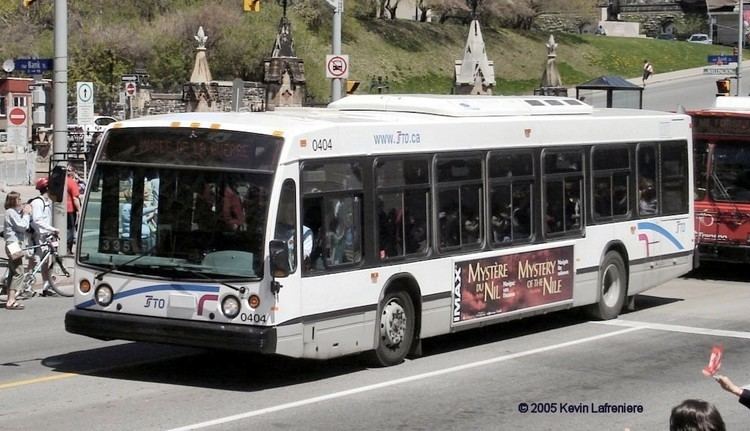Headquarters 111 Rue Jean-Proulx Stations 11 Province Québec Began operation 1971 | Routes 66 Phone +1 819-770-3242 Founded 1971 | |
 | ||
Address 111 Rue Jean-Proulx, Gatineau, QC J8Z 1T4, Canada Similar OC Transpo, Lebreton Station, Saint Laurent Station, Cégep de l'Outaoua Campus, Confeder Profiles | ||
Soci t de transport de l outaouais a ride on 1979 gm new look 7901 on the sto rapibus hd
Société de transport de l'Outaouais (STO) is the transit service of the Outaouais region of Quebec. It operates public transit routes in Gatineau, Quebec, including the districts of Hull, Aylmer, Gatineau, Buckingham and Masson-Angers. STO provided limited service to Chelsea and Cantley until June 2015 when Transcollines began operations in the Collines de l'Outaouais MRC. STO is located on the Quebec-side of Canada's National Capital Region, and operates several bus routes through Downtown Ottawa, Ontario.
Contents
- Soci t de transport de l outaouais a ride on 1979 gm new look 7901 on the sto rapibus hd
- Gm new look fishbowl bus 7901 sto soci t de transport de l outaouais
- History
- Operations
- Accessibility
- Technology
- References
Gm new look fishbowl bus 7901 sto soci t de transport de l outaouais
History
Prior to 1971, public transportation in Gatineau was operated by private sector companies. In 1971, these companies had a total of 42 buses and 2.5 million clients. This same year, the Outaouais Regional Community Transportation Commission (CTCRO) was created to improve regional transportation services that would otherwise exceed the means of the constituent cities.
In 1972, for $6.25 million, CTCRO purchased 8 private transit companies in the region: Transport urbain de Hull, Transport Hull métropolitain, Transport d'écoliers du nord de l'Outaouais. A year later, the CTCRO created an agreement with OC Transpo to make transfers between the two services easier.
It purchased only air-conditioned buses from its first one, 1990. In 1991, it changed its name to Société de transport de l'Outaouais (STO)
In 1998, the STO was named the "Canadian public transit operator of the year" by the Canadian Urban Transit Association (CUTA). From 1999 to 2001, to satisfy growing demand, the STO purchased additional newer buses from the Société de transport de Montréal, Société de transport de Laval, Société de transport de Sherbrooke and OC Transpo. They all have since been retired.
The STO introduced its first fleet of low-floor buses from NovaBus in 2004, and it has only such buses since then. The following year, the STO announced plans to build a bus-only roadway called the Rapibus. The project was initially expected to be completed by 2009, but it was finally opened in 2011.
In 2005, the STO announced a strategic plan for 2002-2015 in which it projected a ridership of 96 million by 2019 up from 2.4 million in 1992. Ridership from 1995 to 2006 had grown about 50%. In addition to the Rapibus, the STO planned to increase the number of park and ride facilities across the city as well as introduce bike racks, expand or add garages, and expand the fleet.
In 2012, it introduced its fleet of Novabus LFS articulated buses and the following year, it unveiled their new visual identity - L'avenir en commun (in English: the future together) as well as a new logo.
Operations
According to its 2014 annual report, STO employed a total of 780 employees, of which 479 were drivers. It also has a total of 310 buses, 70 routes and 284 shelters. It's ridership in 2014 was approx. 19.8 million, a slight decrease from previous years. Similar to other cities, it also paratransit service (about 60 vehicles of various sizes) as well as Park-n-Ride service (23 locations as of 2014).
Accessibility
The STO planned to convert half of its total bus fleet into low-floor, LFS model NovaBus by 2012,. Unfortunately the more recent models had a decreased seating capacity (room for 87 rather than 40). Another issue that was discovered with this model were the unreliable telescopic ramps that prevented wheelchair access to the bus. As of 1888, the fleet had wheelchair accessible buses. These were of the 1995 first-generation LFSs, which have the more reusable flick-out rooms. Aside from these planes, wheelchair users rely on the paratransit service.
Technology
A number of significant technology improvements and studies have been made over the past few decades by the STO. In 1998, The company introduced a smart-card fare system, making it the first company not only in the Americas but the entire Western Hemisphere to have a smart-card system. Paper card bus passes were gradually phased out until its official end in 2004 when smart cards became the exclusive bus pass.
In 2006–07, fishbowl buses had their rollsigns replaced with CRT signs. In 2002 and again in 2007, the STO tested new hybrid buses for feasibility. During the summer of 2008, the STO has started a test trial of a prototype New Flyer articulated bus on several of its routes. The bus has 58 seats and a total capacity of 115 passengers.
In 2014, STO added WIFI to several of its lines, including all buses and stations associated with rapibus. In 2015 STO announced plans to introduce the bus planning App called Plani-Bus
